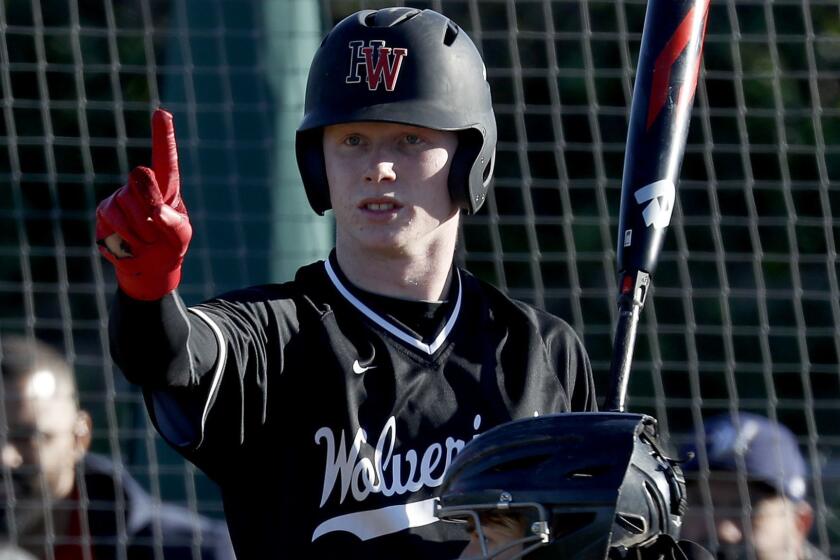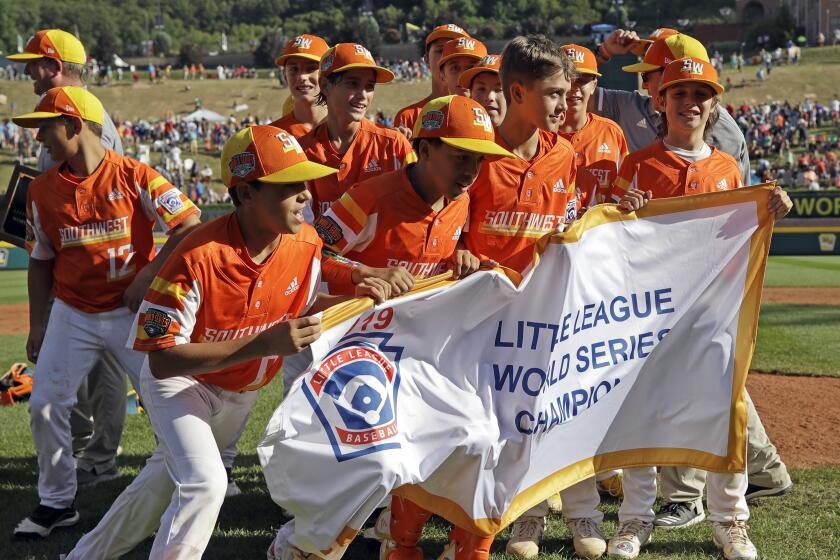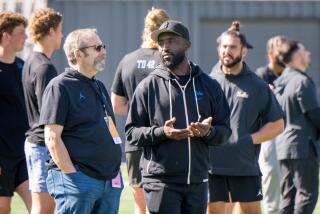Coronavirus outbreak creates a college football recruiting year unlike any other
- Share via
Unfiltered as always, Ed Orgeron offered up a strict rule on “film-only” scholarship offers in the 2007 college football recruiting book, “Meat Market.”
For a player to get an offer based on video scouting alone, the then-Mississippi and future USC and Louisiana State coach said, “He’d better damned well be a no-brainer.”
For good reason. In the musical chairs that is recruiting, little is taken for granted. Coaches want to see recruits in person. Players want to learn about schools for themselves.
The whole process revolves around this “seeing-is-believing” philosophy, and at no point during the months-long recruiting calendar do players and coaches see more of one another than the spring and summer before a prospect’s senior season.
“I tell my players, after spring ball, you can tell who is really interested in you, because a coach will come and see you,” said Chad Johnson, head coach of a Mission Viejo program has been one of the most successful in Southern California at sending players to college in recent years.
But amid the coronavirus crisis this year, the recruiting world has been temporarily turned on its head, with that key spring stretch likely to be wiped out by the COVID-19 pandemic.
Said Brandon Huffman, the national recruiting editor for 247Sports: “It’s definitely recruiting with one hand tied behind the back.”
A look at the high school sport standouts whose seasons were cut short by the coronavirus outbreak.
In this class, relationships will be built in the virtual realm — through video campus tours, such as the one Minnesota recently used to lock up a four-star cornerback from Arizona, and online conference calls, the safest forum for discussion between recruiters and their targets in this time of social distancing.
Armond Hawkins Sr., who co-founded the Ground Zero 7-on-7 program and helps its players’ recruiting processes as the director of recruitment, has found stuck-at-home college coaches to be uncommonly available in recent weeks.
“They’re all receptive because they don’t have anything to do,” said Hawkins., who has sons on the coaching staffs at USC and Arizona State. “I can go over film with them, actually get them to watch the film on the spot.”
In this class, coaches and recruiting experts say that regional bonds will reign. Recruiters will likely focus on players from their school’s local areas, leaning on relationships with familiar high school coaches to fill key voids in the information pipeline. More players might prefer staying close to home too, especially if they aren’t able to visit unfamiliar far-away campuses.
Places such as USC are already beginning to capitalize. Of the six commitments the Trojans have earned in the last two months, five hail from the Southland.
“I don’t want to just commit to somewhere I haven’t been able to visit yet.”
— Johnathan Arceneaux, Lawndale running back
“Kids are going to be more localized with their decision making,” Lawndale coach Travis Clark said. “They won’t have an opportunity to go to the East Coast. They’re not doing all these unofficial visits at this time. So they’re only familiar with what they’re familiar with, and that’s their local schools.”
In this class, most evaluations won’t be finalized until after players’ senior seasons, which will replace much of the scouting usually done in the spring.
“My estimation is that you’re going to see a change not seen in recent years, a return to how recruiting used to be when the senior season still mattered,” Huffman said. “This has the potential to be one of the most complete classes, with less reaches and more guys worthy of an offer because I think more guys are going to have that opportunity in their senior year to get noticed.”
Still, for most players, finding solace hasn’t been easy.
“I’m kind of emotional about it because spring ball is where a lot of recruiting really lifts off,” said running back Johnathan Arceneaux, a three-star recruit according to 247Sports’ composite ranking who recently transferred from Whittier High to Lawndale.
Like other recruits, Arceneaux has been planning this process for years, ever since playing in middle school for a Pop Warner team coached by a former University of Arizona player.
Arceneaux knows, in a normal recruiting cycle, there is an evaluation period from mid-April to the end of May during which coaches see hundreds of recruits in spring high school practices, prospect camps, 7-on-7 tournaments and skills clinics.
Then in June, schools host on-campus camps of their own, where players get the chance to wow entire coaching staffs at once.
By the end of July, pecking orders are set by schools and recruits alike, with most commitments announced before the start of the season or early into the fall, and letters of intent officially signed during the early signing period in December or the traditional window beginning in February.
“I always understood,” Arceneaux said, “your junior football season and then spring ball going into your senior season are always the biggest times.”
Not this year.
Arceneaux has been able to adapt nonetheless. Weeks before coronavirus brought much of society to a halt, his own recruitment started heating up. In early February, San Jose State offered him. Two days later, Fresno State followed suit. At the end of the month, Utah extended a scholarship. By now, more than a dozen other Mountain West and Pac-12 programs have done the same.
“If each school pays attention to each other, they see who offered who,” Arceneaux said, describing a group-think phenomenon that’scommon in recruiting every year, but could become especially pervasive with the class of 2021. “If one school sees another school offered me, they’ll go check my film out and be surprised. And then they’ll get in contact with me.”
The 2020 Little League World Series has been canceled because of concerns over COVID-19. Local leagues are encouraged to play regular seasons.
At the other end of the spectrum are prospects such as Santa Ana Mater Dei’s Nino Remigio. A lightly recruited receiver hoping to follow in the footsteps of his brother, California junior receiver Nikko Remigio, Nino sorely needed to be seen this spring. The soon-to-be senior has been stuck down the depth chart at his powerhouse program, collecting little varsity game tape or widespread attention on the recruiting trail.
This spring was supposed to be his chance to emerge, to catch the eye of evaluators and engineer a path to a college program. He lived in the weight room during the winter and still spends three hours each day working out in the makeshift home gym he and his brother share. He was hoping to become one of the many late bloomers who flourish time of the year.
“This spring would be the main key for me,” Remigio said. “I’d get to show my skill even more in the camps and all that. [Now] we can’t do that. So that’s really messed up everything.”
It’s anybody’s guess as to what the big-picture end result might look like for Remigio or any of his peers. Perhaps the same 3,000 or so players would have wound up at the same 130 Football Bowl Subdivision programs regardless of the COVID-19 pandemic. Or maybe this year will mark a major temporary change with ripple effects that stretch far into the future.
No one knows. And that’s the problem.
“When I finally decide where I want to go for the next four years of my life, I want to know how the campus is and the environment and know the coaching staff well,” Arceneaux said. “I don’t want to just commit to somewhere I haven’t been able to visit yet.”
Like the rest of the world, he might be waiting awhile. This year, no-brainers aren’t an option anymore. Coronavirus has almost everybody in college football flying blind into the relative unknown.
More to Read
Go beyond the scoreboard
Get the latest on L.A.'s teams in the daily Sports Report newsletter.
You may occasionally receive promotional content from the Los Angeles Times.













